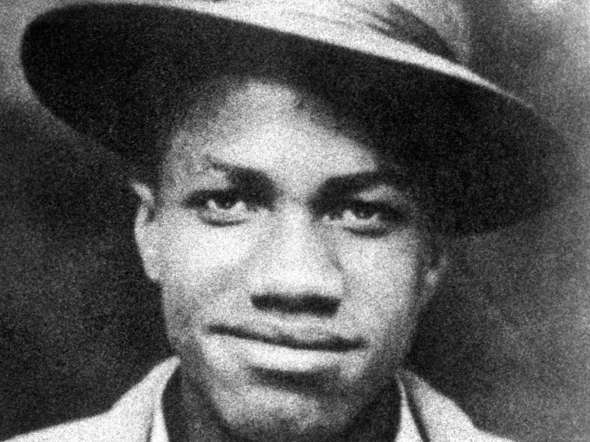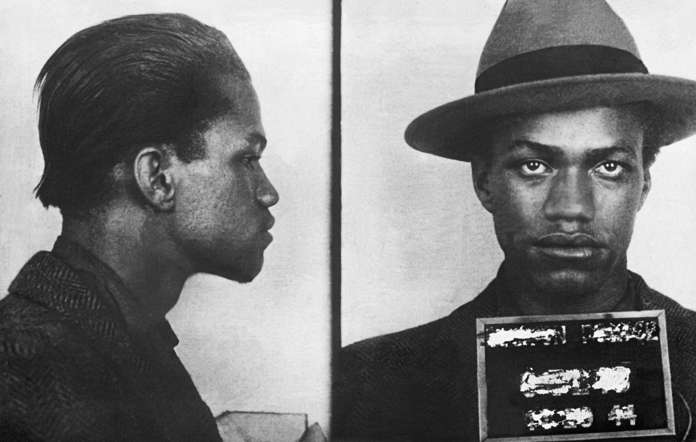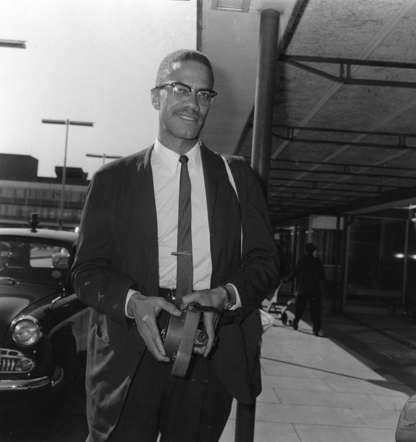On the 50th anniversary of Malcolm X's assassination (February 21, 2015), we remember the significant moments of his life.
 Born in Omaha, Nebraska, Malcolm X’s given name was Malcolm Little. Little had six siblings, three were older than him and three were younger. A Baptist lay speaker by profession, his father, Earl Little, was an admirer of Pan-African activist Marcus Garvey.
Born in Omaha, Nebraska, Malcolm X’s given name was Malcolm Little. Little had six siblings, three were older than him and three were younger. A Baptist lay speaker by profession, his father, Earl Little, was an admirer of Pan-African activist Marcus Garvey. 
When he was just six years old, Malcolm's father was killed, and seven years later, his mother was sent to a mental institution. Following this, Malcolm grew up on his own, moving from one foster home to another. (Pictured) Malcolm X is in the top row, fourth from the left, marked with an X, in this 1940 Mason High School football team photo that appeared in the "Lansing State Journal" in the 1960s.

Back in school, Malcolm Little was a good student and wished to study law. His dream, however, was crushed when one of his white professors told him that his career choice wasn’t a “realistic aspiration" given his race. It was here that Malcolm realized that the world, dominated by white people, offered him no place. When he was 20, he got involved in a series of burglaries, leading to a prison sentence in 1946. (Pictured) Mugshots from 1944.

In jail, Malcolm became a member of the Nation of Islam – a comparatively new religious movement that taught black self-reliance – after speaking to Elijah Muhammad through a letter. Muhammad was the leader of the Nation of Islam at the moment. (Pictured) Malcolm X with Muhammad (R).

In 1950 Malcolm Little changed his name to Malcolm X. The explanation he offered was that "Little" was the name that was forced upon his forefathers by some white man. The same year Malcolm X also wrote a letter from prison to President Truman, voicing his opposition to the Korean War – this led to an FBI file being opened on him.

Malcolm X truly landed in the news when John Hinton, a member of the Nation of Islam, was beaten up by a couple of New York City cops. He led the protests that eventually involved as many as 4,000 people who had all gathered outside the police station where Hinton was kept. Malcolm X demanded that Hinton be taken to a hospital to be treated for injuries – a demand that was ultimately met. 

In 1958, Malcolm X married Betty Sanders three years after meeting her. The couple had six children in total, all girls. 

Malcolm X’s prominence grew, and his opinions were broadcast on the radio, television and in print. In 1960, Malcolm X was invited to a United Nations General Assembly meeting in New York. At the Assembly, he met Fidel Castro, who was fascinated by Malcolm X’s views and invited him to Cuba after a private meeting. Malcolm X opposed Martin Luther King’s civil right movement and called King a “chump”. He believed that blacks should be separate from whites and that blacks should return to Africa. He also believed that a new country should be created for American blacks until they could return to
Malcolm X opposed Martin Luther King’s civil right movement and called King a “chump”. He believed that blacks should be separate from whites and that blacks should return to Africa. He also believed that a new country should be created for American blacks until they could return to
 Malcolm X opposed Martin Luther King’s civil right movement and called King a “chump”. He believed that blacks should be separate from whites and that blacks should return to Africa. He also believed that a new country should be created for American blacks until they could return to
Malcolm X opposed Martin Luther King’s civil right movement and called King a “chump”. He believed that blacks should be separate from whites and that blacks should return to Africa. He also believed that a new country should be created for American blacks until they could return to
Africa
. For as many as 12 years, Malcolm X was one of the most influential members of the Nation of Islam, but by 1964, he became disillusioned by it. He remained outspoken as always and had made controversial statements about the Kennedy assassination in 1963, which is believed to have caused a major stir in his involvement with the Nation of Islam. (Pictured) Malcolm X talking to a group of students at Queens College, New York.
For as many as 12 years, Malcolm X was one of the most influential members of the Nation of Islam, but by 1964, he became disillusioned by it. He remained outspoken as always and had made controversial statements about the Kennedy assassination in 1963, which is believed to have caused a major stir in his involvement with the Nation of Islam. (Pictured) Malcolm X talking to a group of students at Queens College, New York.
 For as many as 12 years, Malcolm X was one of the most influential members of the Nation of Islam, but by 1964, he became disillusioned by it. He remained outspoken as always and had made controversial statements about the Kennedy assassination in 1963, which is believed to have caused a major stir in his involvement with the Nation of Islam. (Pictured) Malcolm X talking to a group of students at Queens College, New York.
For as many as 12 years, Malcolm X was one of the most influential members of the Nation of Islam, but by 1964, he became disillusioned by it. He remained outspoken as always and had made controversial statements about the Kennedy assassination in 1963, which is believed to have caused a major stir in his involvement with the Nation of Islam. (Pictured) Malcolm X talking to a group of students at Queens College, New York.
After leaving the Nation, Malcolm set up the Organization of Afro-American Unity, a secular assembly that preached Pan-Africanism. At this time Malcolm X became influenced by Sunni Muslims who asked him to study their faith. He took it up and converted to Sunni Islam.

In April 1964, Malcom X went to Saudi Arabia and completed his Hajj. It was during this trip that he started to believe that Islam could play a major role in overcoming racial problems. He said that seeing Muslims of “all colors, from blue-eyed blonds to black-skinned Africans” made him realize this.

Malcolm X also traveled to several countries in Africa, including Egypt, Ethiopia, Tanganyika, Nigeria, Ghana, Guinea, Sudan, Senegal, Liberia, Algeria, and Morocco. He gave an important speech at the University of Ibadan, where the Student Association gave him the honorary Yoruba name Omowale (the son who has come home).

Leaving the Nation came at a cost for Malcolm X, who continually received death threats from Nation members throughout 1964. On February 21, 1965 at the Audubon Ballroom in New York City, Malcolm X was assassinated by a man armed with a sawed-off shotgun, who shot him in the chest. Two other men also fired at him with automatic handguns. Malcolm X’s funeral, which took place at Unity Funeral Home in Harlem, was attended by as many as 30,000 mourners. (Pictured) Actor Ossie Davis delivers eulogy for Malcolm X at the funeral service.


No comments:
Post a Comment